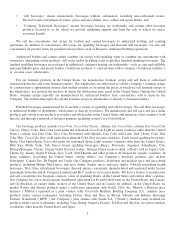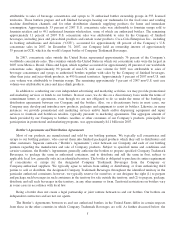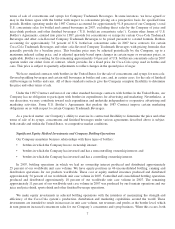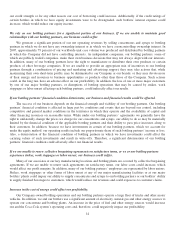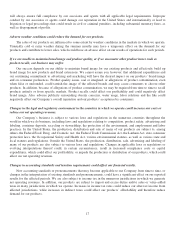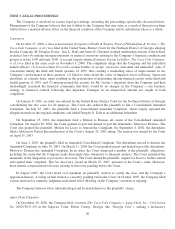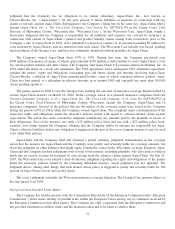Coca Cola 2007 Annual Report Download - page 15
Download and view the complete annual report
Please find page 15 of the 2007 Coca Cola annual report below. You can navigate through the pages in the report by either clicking on the pages listed below, or by using the keyword search tool below to find specific information within the annual report.the industry is being affected by the trend toward consolidation in the retail channel, particularly in Europe and the
United States. If we are unable to successfully adapt to this rapidly changing environment, our net income, share of
sales and volume growth could be negatively affected.
Increased competition could hurt our business.
The nonalcoholic beverages segment of the commercial beverages industry is highly competitive. We compete
with major international beverage companies that, like our Company, operate in multiple geographic areas, as well as
numerous firms that are primarily local in operation. In many countries in which we do business, including the United
States, PepsiCo, Inc. is a primary competitor. Other significant competitors include, but are not limited to, Nestlé,
Cadbury Schweppes plc, Groupe Danone, Kraft Foods Inc. and Unilever. Our ability to gain or maintain share of sales
or gross margins in the global market or in various local markets may be limited as a result of actions by competitors.
If we are unable to expand our operations in developing and emerging markets, our growth rate could be negatively
affected.
Our success depends in part on our ability to grow our business in developing and emerging markets, which in
turn depends on economic and political conditions in those markets and on our ability to acquire or form strategic
business alliances with local bottlers and to make necessary infrastructure enhancements to production facilities,
distribution networks, sales equipment and technology. Moreover, the supply of our products in developing and
emerging markets must match consumers’ demand for those products. Due to product price, limited purchasing power
and cultural differences, there can be no assurance that our products will be accepted in any particular developing or
emerging market.
Fluctuations in foreign currency exchange could affect our financial results.
We earn revenues, pay expenses, own assets and incur liabilities in countries using currencies other than the U.S.
dollar, including the euro, the Japanese yen, the Brazilian real and the Mexican peso. In 2007, we used 67 functional
currencies in addition to the U.S. dollar and derived approximately 74 percent of our net operating revenues from
operations outside of the United States. Because our consolidated financial statements are presented in U.S. dollars, we
must translate revenues, income and expenses, as well as assets and liabilities, into U.S. dollars at exchange rates in
effect during or at the end of each reporting period. Therefore, increases or decreases in the value of the U.S. dollar
against other major currencies will affect our net operating revenues, operating income and the value of balance sheet
items denominated in foreign currencies. Because of the geographic diversity of our operations, weaknesses in some
currencies might be offset by strengths in others over time. We also use derivative financial instruments to further
reduce our net exposure to currency exchange rate fluctuations. However, we cannot assure you that fluctuations in
foreign currency exchange rates, particularly the strengthening of the U.S. dollar against major currencies, would not
materially affect our financial results.
If interest rates increase, our net income could be negatively affected.
We maintain levels of debt that we consider prudent based on our cash flows, interest coverage ratio and
percentage of debt to capital. We use debt financing to lower our cost of capital, which increases our return on
shareowners’ equity. This exposes us to adverse changes in interest rates. When appropriate, we use derivative
financial instruments to reduce our exposure to interest rate risks. We cannot assure you, however, that our financial
risk management program will be successful in reducing the risks inherent in exposures to interest rate fluctuations.
Our interest expense is also affected by our credit ratings. In assessing our credit strength, credit rating agencies
consider our capital structure and financial policies as well as the aggregate balance sheet and other financial
information for the Company and certain major bottlers. It is our expectation that the credit rating agencies will
continue using this methodology. If our credit ratings were to be downgraded as a result of changes in our capital
structure, our major bottlers’ financial performance, changes in the credit rating agencies’ methodology in assessing
13


